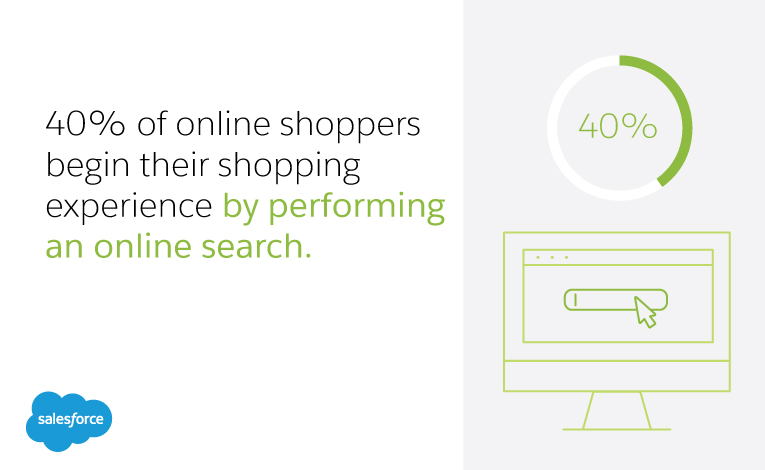The Importance of Ecommerce Analytics
Because technology evolves rapidly and shopping trends shift on a daily basis, ecommerce is in a constant state of adaptation that can leave brands fumbling in the dark. To keep up, ecommerce businesses must anticipate changes in the market using reliable data insights. In short, they need effective ecommerce analytics.

What we will cover:
- Grow your customer base with SEO, SEM, and email campaign insights.
- Reaching new customers is important, but holding onto them is crucial.
- Optimize your website with data-driven insights.
- Don’t be afraid to talk directly with your customers.
- Capture customer data no matter how or where they shop.
- Importance of E-commerce Analytics: Key facts and FAQs

Grow your customer base with SEO, SEM, and email campaign insights.
Did you know that nearly 40% of online shoppers begin their shopping experience by performing an online search? As a result, any business that is not focusing on search engine optimization (SEO) is missing out on a huge chunk of the consumer base. Effective SEO optimization begins with research into search volumes, competitor rankings, and searcher intent. It also includes understanding your search engine results page (SERP) rankings, creating superior meta tags to your competitors, developing accurate site maps, and constructing effective, consumer-friendly URLs. There are a lot of SEO analytic tools that can help you accomplish these goals, but we recommend looking for those that include keyword planning, ranking trackers, and the ability to track bounce rates and conversions.
SEO optimization should not be your only focus for new customer acquisition. Paid search engine marketing (SEM) campaigns can edge you ahead of the competition and help you win more shoppers. To succeed in this area, you will need analytic tools that measure search volume, cost per click (CPC), average ranking position, click-through rate (CTR), and again, bounce and conversion rates.
In addition to SEO and SEM, email marketing campaigns can help you reach new prospects and boost traffic to your ecommerce website. To track email performance and develop informed campaign strategies, look for ecommerce analytics tools that measure the number and source of your email subscribers, total sales made from email campaigns, conversion rates, open rates, click-through rates, and unsubscribe rates.
Reaching new customers is important, but holding onto them is crucial.
New customer acquisition may give your business legs, but customer retention is truly the backbone of your brand’s sustained success. According to experts, 80% of future revenue will come from 20% of your existing clients. As such, it is important to focus on customer loyalty management, repeat business, and overall customer satisfaction.
In order to understand and cultivate customer relationships — and really tap into that valuable 20% — consider tracking KPIs like overall lifetime value, returning visitors, purchasing behavior, social shares, subscription renewals, and upgrades. Beyond click tracking, conversion tracking, and social media tracking tools, we recommend using a comprehensive customer relationship management (CRM) solution. CRM platforms will provide all of the aforementioned tracking, with the added benefit of sophisticated audience segmentation, customer targeting, and AI-driven analytics that aid in marketing decisions. Armed with these capabilities, you will know how to reach the right people with the right deals at the right time, using the most appropriate channel.
Optimize your website with data-driven insights.
Effective website design, UX optimization, and streamlined checkout flows help you connect shoppers to products and boost conversion rates, but how do you know what’s working and what’s not? Ecommerce analytics can provide you with data-driven insights into how shoppers interact with your site — both the good and the bad. These insights take the guesswork and subjectivity out of website optimization, and uncover opportunities for improvement and innovation.
Key focus areas include a user-friendly checkout flow, optimal product presentation and recommendations, and overall usability. To truly maximize the effectiveness of these areas, we recommend tools that enable conversion rate optimization (CRO) testing, A/B and multivariate landing page testing, heat mapping, click tracking, visitor recording, and more.
Don’t be afraid to talk directly with your customers.
Capture customer data no matter how or where they shop.
RESEARCH REPORT
Consumer Study Reveals the New Rules of Retail
That’s a lot of info!
Here’s what you should take away from this article:
- What is ecommerce analytics? Ecommerce analytics involves tools or strategies for analysing large data volumes and producing actionable insights into client behaviour.
- How can SEO tools grow your customer base? Almost 40% of online shoppers start with a search. Today, ranking highly in the search engine results is vital. SEO tools can grow your customer base by helping you optimise your content, which will improve your search engine rankings.
- What makes repeat business so valuable? Most future revenue comes from repeat business, so analysing customer behaviour as part of effective customer relationship management is crucial.
- How can ecommerce analytics optimise your website? Ecommerce analytics provides comprehensive data-driven insights from shopper interactions to take the guesswork out of optimising your website’s functionality.
- Is direct customer feedback still important? Direct customer feedback – such as online surveys, livechat, reviews and social media trackers – is irreplaceable, even in today’s data-driven world.
- How is ecommerce analytics evolving? Ecommerce analytics is evolving to keep pace with customer journeys, tracking purchases across every touchpoint – mobile, social, web and store.
Frequently Asked Questions
What is Ecommerce Analytics?
How do you analyze ecommerce data?
What are KPIs for ecommerce?
See Commerce Cloud in Action



